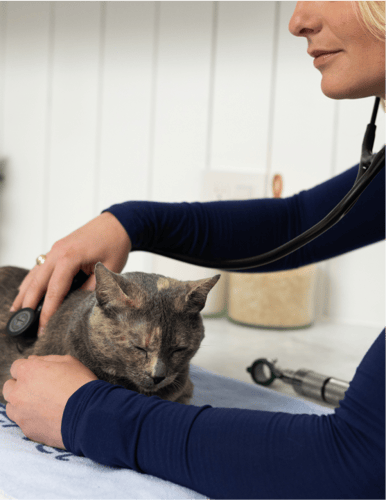Why BetterVet?
Our mobile veterinarians examine pets in their favorite spot - a comfy couch, a cozy pet bed, or even your lap! See how we work to keep pets relaxed and happy at home.
If your pet is showing signs of chronic pain, a BetterVet veterinarian will come to your home to determine the cause(s) of the discomfort and create a tailored plan to help your pet feel better as soon as possible.
Note: Pain Management consultations are included in the cost of an in-home physical examination. To book a Pain Management consultation, choose Sick Visit for the service type, and specify the reason for your appointment.

Whether you have an ill, senior, or physically-impaired pet, treatment from home provides the maximum level of comfort and convenience.
Especially when they’re in pain, pets rely on their daily routines and comfort of home for a sense of safety and security. Give them added support and stability by scheduling expert care from home, minimizing disruption to their routines.
Home visits also enable our expert veterinarians to observe pets when they are more relaxed, helping them best assess your pet’s health and mobility.
During an in-home visit, your veterinary team will create a plan to manage your pet’s pain and provide any necessary prescriptions to get them feeling better soon without the need to transport your pet to a clinic.
Our experienced veterinarians will guide you through all available treatment options, making sure you have access to all the tools you need to keep them comfortable.

Your pet’s pain management consultation begins with a thorough health history and physical examination to assess their overall wellness and identify the source of their pain.

Based on your pet’s health condition, and the results of any recommended testing, your veterinary team will create a pet pain management plan tailored to their specific needs, including gentle pain relief to offer your pet immediate comfort and post-visit support.

Our experienced veterinarians will guide you through every step of the pain management process, answering any questions you may have and ensuring that you have all the information you need to make the best plan for your pet.

If your pet needs any additional diagnostic testing or a referral to an outside specialist, your veterinarian will make clear recommendations for any next steps.

My dog had an emergency injury during the weekend and her current vet couldn't see her for 2+ weeks! BetterVet was able to come to my home first thing on Monday morning, and they were excellent with my dog and her injury. Drs. were so kind and helpful, and they put me right at ease. Will definitely use BetterVet again!
We begin with a comprehensive pain assessment by one of our expert veterinarians to identify what’s hurting. Based on their assessment, we will create a plan for your pet that may include medication, dietary recommendations, and other therapies.
Pets communicate their pain in a variety of subtle ways. Our veterinarians are trained to assess and diagnose pain based on your pet’s physical and behavioral cues. After pinpointing the source of your pet’s discomfort, they can recommend the best course of action.
Based on your pet’s history and health, your veterinary team may recommend physical rehabilitation and therapy services to reduce pain and improve mobility. They will make sure to provide you with a referral to specialists in your area.
Your veterinarian will also make any recommendations for dietary changes and/or supplements if helpful in managing your pet’s symptoms.
If your pet’s pain is best managed with over-the-counter or prescription medication, your veterinarian will recommend and prescribe the appropriate medicine. Our veterinarians keep up with promising new treatments for pet pain and will keep you informed about your best options.
If your pet has had a recent surgery, your veterinary team will make sure that you have a plan for pain management and a prescription for any necessary post-operative medication(s).
If your pet is nearing their final stages of life, we can assess their quality of life and help keep them as comfortable as possible at home. When the time comes, our compassionate veterinarians can also assist with in-home euthanasia so your pet can cross the rainbow bridge in a peaceful and pain-free environment.
A typical in-home Sick Visit, which includes a pain management consultation, lasts approximately 30–60 minutes.
If your pet is diagnosed with a more serious issue or health condition, your veterinarian will work with you to develop a treatment plan to help maintain your pet’s quality of life and keep them comfortable for as long as possible.
The more information you have, the more helpful it is for your veterinary team. Be prepared to share your pet’s history, current medications, and observations of your pet’s symptoms.
If your pet requires additional diagnostic testing, your veterinarian will either perform testing during your appointment or provide a referral to an outside specialist (for an additional cost). Please visit our pricing page for more information.
We have appointment availability as soon as the same day or the next day in many locations. To book a Pain Management appointment, choose the Sick Visit option from our list of services on our website or app.
All of our veterinarians are board-certified in small animal medicine and experienced and qualified to assess and treat pet pain.
Our Wellness Club membership plans are a cost-effective option for pets with ongoing health needs, including pain management. All of our plans include unlimited free travel fees and telemedicine, making it easy and affordable to access the care your pet needs with a flat monthly payment.
Your veterinary team will make sure to give you detailed post-visit instructions for your pet’s care as well as any necessary prescriptions or referrals.
Skip the traffic by booking a mobile vet visit with one of our trusted veterinarians. We bring full-service vet care to you!